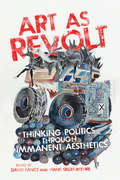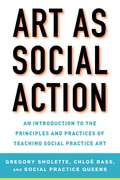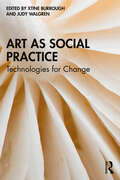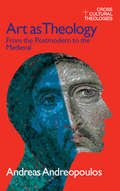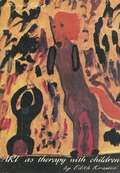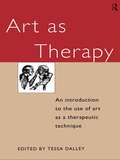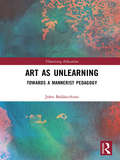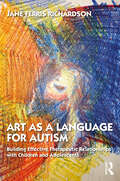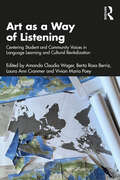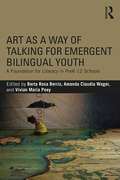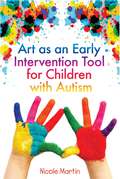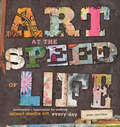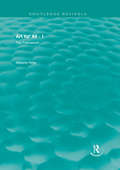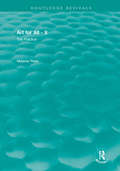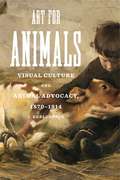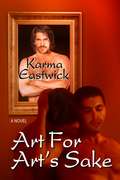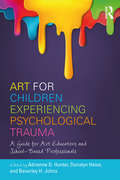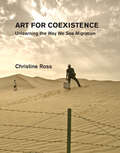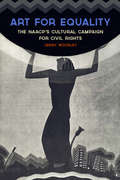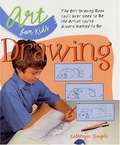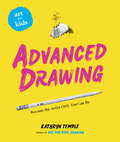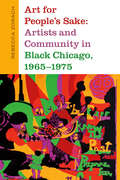- Table View
- List View
Art as Revolt: Thinking Politics through Immanent Aesthetics
by David Fancy and Hans Skott-MyhreHow can we imagine a future not driven by capitalist assumptions about humans and the wider world? How are a range of contemporary artistic and popular cultural practices already providing pathways to post-capitalist futures? Authors from a variety of disciplines answer these questions through writings on blues and hip hop, virtual reality, post-colonial science fiction, virtual gaming, riot grrrls and punk, raku pottery, post-pornography fanzines, zombie films, and role playing. The essays in Art as Revolt are clustered around themes such as technology and the future, aesthetics and resistance, and ethnographies of the self beyond traditional understandings of identity. Using philosophies of immanence – describing a system that gives rise to itself, independent of outside forces – drawn from a rich and evolving tradition that includes Spinoza, Nietzsche, Deleuze, and Braidotti, the authors and editors provide an engrossing range of analysis and speculation. Together the essays, written by experts in their fields, stage an important collective, transdisciplinary conversation about how best to talk about art and politics today. Sophisticated in its theoretical and philosophical premises, and engaging some of the most pressing questions in cultural studies and artistic practice today, Art as Revolt does not provide comfortable closure. Instead, it is understood by its authors to be a “Dionysian machine,” a generator of open-ended possibility and potential that challenges readers to affirm their own belief in the futures of this world. Contributors include Timothy J. Beck (University of West Georgia), Mark Bishop (Independent Scholar), Dave Collins (University of West Georgia), David Fancy (Brock University), Veronica Pacini-Ketchabaw (University of Western Ontario), Malisa Kurtz (Independent Scholar), Nicole Land (Ryerson University), Eric Lochhead (Youth Author Calgary Alberta), Douglas Ord (Doctoral Student University of Western Ontario), Joanna Perkins (Independent Scholar), Peter Rehberg (Institute for Cultural Inquiry—Berlin), Chris Richardson (Young Harris College), Hans Skott-Myhre (Kennesaw State University), and Kathleen Skott-Myhre (University of West Georgia).
Art as Social Action: An Introduction to the Principles and Practices of Teaching Social Practice Art
by Gregory Sholette Chloë Bass Social Practice Queens"Art as Social Action . . . is an essential guide to deepening social art practices and teaching them to students." —Laura Raicovich, president and executive director, Queens MuseumArt as Social Action is both a general introduction to and an illustrated, practical textbook for the field of social practice, an art medium that has been gaining popularity in the public sphere. With content arranged thematically around such topics as direct action, alternative organizing, urban imaginaries, anti-bias work, and collective learning, among others, Art as Social Action is a comprehensive manual for teachers about how to teach art as social practice. Along with a series of introductions by leading social practice artists in the field, valuable lesson plans offer examples of pedagogical projects for instructors at both college and high school levels with contributions written by prominent social practice artists, teachers, and thinkers, including: Mary Jane Jacob Maureen Connor Brian Rosa Pablo Helguera Jen de los Reyes Jeanne van Heeswick Jaishri Abichandani Loraine Leeson Ala Plastica Daniel Tucker Fiona Whelan Bo Zheng Dipti Desai Noah Fischer Lesson plans also reflect the ongoing pedagogical and art action work of Social Practice Queens (SPQ), a unique partnership between Queens College CUNY and the Queens Museum.
Art as Social Practice: Technologies for Change
by Xtine Burrough Judy WalgrenWith a focus on socially engaged art practices in the twenty-first century, this book explores how artists use their creative practices to raise consciousness, form communities, create change, and bring forth social impact through new technologies and digital practices. Suzanne Lacy’s Foreword and section introduction authors Anne Balsamo, Harrell Fletcher, Natalie Loveless, Karen Moss, and Stephanie Rothenberg present twenty-five in-depth case studies by established and emerging contemporary artists including Kim Abeles, Christopher Blay, Joseph DeLappe, Mary Beth Heffernan, Chris Johnson, Rebekah Modrak, Praba Pilar, Tabita Rezaire, Sylvain Souklaye, and collaborators Victoria Vesna and Siddharth Ramakrishnan. Artists offer firsthand insight into how they activate methods used in socially engaged art projects from the twentieth century and incorporated new technologies to create twenty-first century, socially engaged, digital art practices. Works highlighted in this book span collaborative image-making, immersive experiences, telematic art, time machines, artificial intelligence, and physical computing. These reflective case studies reveal how the artists collaborate with participants and communities, and have found ways to expand, transform, reimagine, and create new platforms for meaningful exchange in both physical and virtual spaces. An invaluable resource for students and scholars of art, technology, and new media, as well as artists interested in exploring these intersections.
Art as Theology: From the Postmodern to the Medieval
by Andreas AndreapoulosReligion and spirituality are key aspects of the contemporary art scene. Following Ronald Barthes' 'death of the author' - which argued for the dissociation of work from creator - works of art have withdrawn as independent objects, giving way to a growing religious awareness or practice. 'Art and Theology' examines the connection between art and religion in ancient Jewish drama, Greek tragedy, the Renaissance, the Byzantine icon and the medieval cathedral. The book explores how art lost its sacred character in the late Middle Ages and how the current withdrawal or 'death' of art and the fusion of the limits of art and life are consistent with the medieval view of the religious icon.
Art as Therapy with Children (2nd Edition)
by Edith KramerArt as Therapy with Children has been an invaluable text for students of art therapy since its original printing in 1971. Though the settings and populations about which Edith Kramer wrote have changed considerably in the past two decades, the human condition and the need to understand and assist children in trouble remains unaltered. Edith Kramer's description of her methods and theories hold up as well as the methods and theories themselves.
Art as Therapy: An Introduction to the Use of Art as a Therapeutic Technique (Social Science Paperbacks Ser. #Vol. 265)
by Tessa DalleyArt as Therapy introduces the theory and practice of art therapy in a concise, accessible and informative way. Tessa Dalley's introduction gives an overview of basic issues, research and development. Subsequent chapters, written by specialists, are chosen to demonstrate the ways in which art therapy can be applied to different client groups, in a variety of clinical settings. These include children, adolescents suffering from anorexia nervosa, the mentally handicapped, the elderly and terminally ill, those in psychiatric hospitals and prison inmates. Illustrated case studies provide visual explanations for the art therapy processes and the final chapter discusses training for the profession. Art as Therapy has been welcomed by art therapists, social workers, psychologists, nurses and teachers.
Art as Unlearning: Towards a Mannerist Pedagogy (Theorizing Education)
by John BaldacchinoArt as Unlearning makes an argument for art’s unlearning as a mannerist pedagogy. Art’s pedagogy facilitates a form of forgetfulness by extending what happens in the practice of the arts in their visual, auditory and performative forms. The concept of learning has become predominantly hijacked by foundational paradigms such as developmental narratives whose positivistic approach has limited the field of education to a narrow practice within the social sciences. This book moves away from these strictures by showing how the arts confirm that unlearning is not contingent on learning, but rather anticipates and avoids it. This book cites the experience and work of artists who, by unlearning the canon, have opened a diversity of possibilities by which we make and live the world. Moving beyond clichés of art’s teachability and what we have to learn through the arts, it advances a scenario where unlearning is uniquely presented to us by the diverse practices that we identify with the arts. The very notion of art as unlearning stems from and represents a fundamental critique of the constructivist pedagogies that have dominated arts education for over half a century. This book will be of great interest to academics, researchers and postgraduate students in the fields of education, philosophy of education, history of education, pedagogy of art and art education. It will also appeal to educators, art educators, and artists interested in the pedagogy of art.
Art as a Language for Autism: Building Effective Therapeutic Relationships with Children and Adolescents
by Jane Ferris RichardsonArt as a Language for Autism addresses the clinical challenges that are common in working with autistic spectrum disorder by exploring how artistic expression can provide a communicative language for younger clients who are set in their thought processes and preferences. Exploring how both art and play-based approaches can be effective tools for engaging therapeutic work, this book introduces strategies to help young clients find expressive "languages" that can fully support communication, expression, and empathic understanding, as well as build skills for relaxation, calming, and coping. Building from a foundation of a client’s individual strengths and interests, this playful and integrative approach is informed by an awareness of the individual sensory profiles and the developmental needs of children and adolescents with autism. Through a greater awareness of these materials and processes for therapy, the reader will be able to create a space for their young clients to share what they know and care about. This exciting new book is essential reading for clinicians working with children and adolescents on the autism spectrum.
Art as a Way of Listening: Centering Student and Community Voices in Language Learning and Cultural Revitalization
by Berta Rosa Berriz Amanda Claudia Wager Vivian Maria Poey Laura Ann CranmerOffering a wealth of art-based practices, this volume invites readers to reimagine the joyful possibility and power of language and culture in language and literacy learning. Understanding art as a tool that can be used for decolonizing minds, the contributors explore new methods and strategies for supporting the language and literacy learning skills of multilingual students. Contributors are artists, educators, and researchers who bring together cutting-edge theory and practice to present a broad range of traditional and innovative art forms and media that spotlight the roles of artful resistance and multilingual activism. Featuring questions for reflection and curricular applications, chapters address theoretical issues and pedagogical strategies related to arts and language learning, including narrative inquiry, journaling, social media, oral storytelling, and advocacy projects. The innovative methods and strategies in this book demonstrate how arts-based, decolonizing practices are essential in fostering inclusive educational environments and supporting multilingual students’ cultural and linguistic repertoires. Transformative and engaging, this text is a key resource for educators, scholars, and researchers in literacy and language education.
Art as a Way of Talking for Emergent Bilingual Youth: A Foundation for Literacy in PreK-12 Schools
by Berta Rosa Berriz Amanda Claudia Wager Vivian Maria PoeyThis book features effective artistic practices to improve literacy and language skills for emergent bilinguals in PreK-12 schools. Including insights from key voices from the field, this book highlights how artistic practices can increase proficiency in emergent language learners and students with limited access to academic English. Challenging current prescriptions for teaching English to language learners, the arts-integrated framework in this book is grounded in a sense of student and teacher agency and offers key pedagogical tools to build upon students’ sociocultural knowledge and improve language competence and confidence. Offering rich and diverse examples of using the arts as a way of talking, this volume invites teacher educators, teachers, artists, and researchers to reconsider how to fully engage students in their own learning and best use the resources within their own multilingual educational settings and communities.
Art as an Early Intervention Tool for Children with Autism
by Nicole MartinThe early years are the most critical period of learning for a child with autism. Therapeutic art-making can be a useful tool to tap into their imaginations and help them to express their thoughts and feelings. Art as an Early Intervention Tool for Children with Autism includes practical advice on helping a child move beyond scribbling, organizing the child's environment for maximum comfort and relaxation, and providing physical and sensory support. This book is packed with tips and suggestions for how to provide art therapy for children with autism -- covering topics such as the basic materials required, safety issues, how to set up a workspace, and ideas for managing difficult behavior. The author writes from a professional and personal perspective -- Nicole Martin is a qualified art therapist specializing in working with children with autism, and she also has a brother with autism. Perfect for busy parents and as a practical reference for professionals such as psychologists, teachers, occupational therapists, sensory integration therapists and anyone working with a child on the autism spectrum.
Art at the Speed of Life: motivation + inspiration for making mixed-media art every day
by Pam CarrikerOffering terrific mixed-media art projects, as well as great tips for getting organized and inspired, Art at the Speed of Life is a treasure chest of ideas for the artist whose fiery enthusiasm for creating art goes up in smoke after that frantic pace of a long day. Author and mixed-media artist Pam Carriker will prove to you that art and life can co-exist productively and happily, while making daily creative outlets a reality and not just wishful thinking.Each chapter in Art at the Speed of Life includes both essays and project ideas from a variety of contributors, including Suzi Blu, Lisa Bebi, Christy Hydeck, Paulette Insall, Cate Calacous Prato. It all begins with prepatory advice on how to manage your supplies and physically make space for you to work. This is followed by more than 15 projects that are inspiring, yet easy to complete on even the tightest of schedules and includes fun techniques such as assemblages, image transfers, and collages that are sure to keep you motivated. Plus, a bonus seven-day project journal helps you track your work as you go. Offering a unique combination of realistic time-management tips, inspiring essays, and easy-to-fit-in projects, Art at the Speed of Life will help you realize your dream of making art every day easily and happily.
Art before the Law
by Ruth RonenEver since Plato expelled the poets from his ideal state, the ethics of art has had to confront philosophy's denial of art's morality. In Art before the Law, Ruth Ronen proposes a new outlook on the ethics of art by arguing that art insists on this tradition of denial, affirming its singular ethics through negativity.Ronen treats the mechanism of negation as the basis for the relationship between art and ethics. She shows how, through moves of denial, resistance, and denouncement, art exploits its negative relation to morality. While deception, fiction, and transgression allegedly locate art outside morality and ethics, Ronen argues they enable art to reveal the significance of the moral law, its origins, and the idea of the good. By employing the thought of Freud and Lacan, Ronen reconsiders the aesthetic tradition from Plato through Kant and later philosophers of art in order to establish an ethics of art. An interdisciplinary study, Art before the Law is sure to be of interest both to academic philosophers and to those interested in psychoanalytic theory and practice.
Art beyond Itself: Anthropology for a Society without a Story Line
by David Frye Néstor García CancliniFirst published in Spanish in 2010, Art beyond Itself is Néstor García Canclini's deft assessment of contemporary art. The renowned cultural critic suggests that, ideally, art is the place of imminence, the place where we glimpse something just about to happen. Yet, as he demonstrates, defining contemporary art and its role in society is an ever more complicated endeavor. Museums, auction houses, artists, and major actors in economics, politics, and the media are increasingly chummy and interdependent. Art is expanding into urban development and the design and tourism industries. Art practices based on objects are displaced by practices based on contexts. Aesthetic distinctions dissolve as artworks are inserted into the media, urban spaces, digital networks, and social forums. Oppositional artists are adrift in a society without a clear story line. What, after all, counts as transgression in a world of diverse and fragmentary narratives? Seeking a new analytic framework for understanding contemporary art, García Canclini is attentive to particular artworks; to artists including Francis Alÿs, León Ferrari, Teresa Margolles, Antoni Muntadas, and Gabriel Orozco; and to efforts to preserve, for art and artists, some degree of independence from religion, politics, the media, and the market.
Art for All - I: The Framework (Routledge Revivals)
by Melanie PeterOriginally published in 1996, Art for All is aimed at the non-specialist teacher of art, and offers a practical approach for working with pupils with wide-ranging learning needs. It presents a developmental framework for art in the light of National Curriculum requirements, with strategies for structuring and supporting appropriate art activity. It is presented in two volumes with colour illustrations: The Framework, which describes the principles of art education in relation to pupils learning difficulties and The Practice, which deals with the specifics of delivering these principles in the classroom. Whilst they stand as independent texts, they are intended to be used together. Art for All will be of interest to all those working in this and related fields in mainstream as well as special education.
Art for All - II: The Practice (Routledge Revivals)
by Melanie PeterOriginally published in 1996, Art for All is aimed at the non-specialist teacher of art, and offers a practical approach for working with pupils with wide-ranging learning needs. It presents a developmental framework for art in the light of National Curriculum requirements, with strategies for structuring and supporting appropriate art activity. It is presented in two volumes with colour illustrations: The Framework, which describes the principles of art education in relation to pupils learning difficulties and The Practice, which deals with the specifics of delivering these principles in the classroom. Whilst they stand as independent texts, they are intended to be used together. Art for All will be of interest to all those working in this and related fields in mainstream as well as special education.
Art for Animals: Visual Culture and Animal Advocacy, 1870–1914 (Animalibus)
by J. Keri CroninAnimal rights activists today regularly use visual imagery in their efforts to shape the public’s understanding of what it means to be “kind,” “cruel,” and “inhumane” toward animals. Art for Animals explores the early history of this form of advocacy through the images and the people who harnessed their power.Following in the footsteps of earlier-formed organizations like the RSPCA and ASPCA, animal advocacy groups such as the Victoria Street Society for the Protection of Animals from Vivisection made significant use of visual art in literature and campaign materials. But, enabled by new and improved technologies and techniques, they took the imagery much further than their predecessors did, turning toward vivid, pointed, and at times graphic depictions of human-animal interactions. Keri Cronin explains why the activist community embraced this approach, details how the use of such tools played a critical role in educational and reform movements in the United States, Canada, and England, and traces their impact in public and private spaces. Far from being peripheral illustrations of points articulated in written texts or argued in impassioned speeches, these photographs, prints, paintings, exhibitions, “magic lantern” slides, and films were key components of animal advocacy at the time, both educating the general public and creating a sense of shared identity among the reformers.Uniquely focused on imagery from the early days of the animal rights movement and filled with striking visuals, Art for Animals sheds new light on the history and development of modern animal advocacy.
Art for Animals: Visual Culture and Animal Advocacy, 1870–1914 (Animalibus: Of Animals and Cultures #12)
by J. Keri CroninAnimal rights activists today regularly use visual imagery in their efforts to shape the public’s understanding of what it means to be “kind,” “cruel,” and “inhumane” toward animals. Art for Animals explores the early history of this form of advocacy through the images and the people who harnessed their power.Following in the footsteps of earlier-formed organizations like the RSPCA and ASPCA, animal advocacy groups such as the Victoria Street Society for the Protection of Animals from Vivisection made significant use of visual art in literature and campaign materials. But, enabled by new and improved technologies and techniques, they took the imagery much further than their predecessors did, turning toward vivid, pointed, and at times graphic depictions of human-animal interactions. Keri Cronin explains why the activist community embraced this approach, details how the use of such tools played a critical role in educational and reform movements in the United States, Canada, and England, and traces their impact in public and private spaces. Far from being peripheral illustrations of points articulated in written texts or argued in impassioned speeches, these photographs, prints, paintings, exhibitions, “magic lantern” slides, and films were key components of animal advocacy at the time, both educating the general public and creating a sense of shared identity among the reformers.Uniquely focused on imagery from the early days of the animal rights movement and filled with striking visuals, Art for Animals sheds new light on the history and development of modern animal advocacy.
Art for Art's Sake
by Karma EastwickIn the quaint, sleepy college town of Huntsville, history has an eerie way of repeating itself generation after generation ...When in-the-closet college student Matthew Rhodes arrives at the old building in the town's historical district, little does he realize his life is about to take a sudden and dramatic turn. He is certainly prepared to earn extra income by posing nude for erotica artist Skylar Novak, and definitely anxious to discover if the sexy and reclusive man has an interest in him other than one of an artistic nature. But things get complicated when Matthew meets a handsome stranger lurking outside the artist's door. A stranger who has a sudden and compelling effect on him before disappearing in the blink of an eye.Matthew and Skylar quickly discover they share both an uncontrollable and supernatural bond with each other, leading to a red-hot and steamy affair, but they also realize they are mysteriously linked to the stranger. Is he even a man at all, or could he be an entity from another plane of existence with lecherous designs of his own? And could his connection to Matthew and Skylar have historical significance, involving an elaborate and desperate plan that has miserably failed every generation for centuries?Before the situation can drive him insane, Matthew is determined to open his mind to new possibilities and learn the whole truth. But in doing so, will his burgeoning love and unquenchable sexual appetite for Skylar, the man of his dreams, suffer in the process? Or will his actions secure their love for eternity?
Art for Children Experiencing Psychological Trauma: A Guide for Art Educators and School-Based Professionals
by Beverley H. Johns Adrienne D. Hunter Donalyn HeiseArt for Children Experiencing Psychological Trauma aims to increase understanding of art’s potential to enhance learning for children living in crisis. In this ground-breaking resource, the first of its kind to focus specifically on the connection between art education and psychological trauma in youth populations, readers can find resources and practical strategies for both teachers and other school-based professionals. Also included are successful models of art education for diverse populations, with specific attention to youth who face emotional, mental, behavioral, and physical challenges, as well a framework for meaningful visual arts education for at-risk/in-crisis populations.
Art for Coexistence: Unlearning the Way We See Migration
by Christine RossAn exploration of how contemporary art reframes and humanizes migration, calling for coexistence—the recognition of the interdependence of beings.In Art for Coexistence, art historian Christine Ross examines contemporary art&’s response to migration, showing that art invites us to abandon our preconceptions about the current &“crisis&”—to unlearn them—and to see migration more critically, more disobediently. We (viewers in Europe and North America) must come to see migration in terms of coexistence: the interdependence of beings. The artworks explored by Ross reveal, contest, rethink, delink, and relink more reciprocally the interdependencies shaping migration today—connecting citizens-on-the-move from some of the poorest countries and acknowledged citizens of some of the wealthiest countries and democracies worldwide. These installations, videos, virtual reality works, webcasts, sculptures, graffiti, paintings, photographs, and a rescue boat, by artists including Banksy, Ai Weiwei, Alejandro González Iñárritu, Laura Waddington, Tania Bruguera, and others, demonstrate art&’s power to mediate experiences of migration. Ross argues that art invents a set of interconnected calls for more mutual forms of coexistence: to historicize, to become responsible, to empathize, and to story-tell. Art history, Ross tells us, must discard the legacy of imperialist museology—which dissocializes, dehistoricizes, and depoliticizes art. It must reinvent itself, engaging with political philosophy, postcolonial, decolonial, Black, and Indigenous studies, and critical refugee and migrant studies.
Art for Equality: The NAACP's Cultural Campaign for Civil Rights (Civil Rights and the Struggle for Black Equality in the Twentieth Century)
by Jenny WoodleyA study of the NAACP’s activism in the cultural realm through creative projects from 1910 to the 1960s.The National Association for the Advancement of Colored People (NAACP) is the nation’s oldest civil rights organization, having dedicated itself to the fight for racial equality since 1909. While the group helped achieve substantial victories in the courtroom, the struggle for civil rights extended beyond gaining political support. It also required changing social attitudes. The NAACP thus worked to alter existing prejudices through the production of art that countered racist depictions of African Americans, focusing its efforts not only on changing the attitudes of the White middle class but also on encouraging racial pride and a sense of identity in the Black community.Art for Equality explores an important and little-studied side of the NAACP’s activism in the cultural realm. In openly supporting African American artists, writers, and musicians in their creative endeavors, the organization aimed to change the way the public viewed the Black community. By overcoming stereotypes and the belief of the majority that African Americans were physically, intellectually, and morally inferior to Whites, the NAACP believed it could begin to defeat racism.Illuminating important protests, from the fight against the 1915 film The Birth of a Nation to the production of anti-lynching art during the Harlem Renaissance, this insightful volume examines the successes and failures of the NAACP’s cultural campaign from 1910 to the 1960s. Exploring the roles of gender and class in shaping the association's patronage of the arts, Art for Equality offers an in-depth analysis of the social and cultural climate during a time of radical change in America.Praise for Art for Equality“A well-conceived and well-executed study that will add significantly to the historiography of the NAACP, the long civil rights movement, and African American history.” —John Kirk, George W. Donaghey Professor and Chair of the History Department at the University of Arkansas at Little Rock“In this insightful book, Woodley writes with great verve and confidence. As a result, Art for Equality will attract readers in a variety of fields from African American history to art history to American political history.” —Matthew Pratt Guterl, Brown University“A necessary contribution to African American social and cultural histories.” —Journal of Southern History
Art for Kids Drawing
by Kathryn TempleWith the help of lots of exercises, budding artists will learn the basic elements of shapes (lines, dots, circles) and see how to combine them to make familiar forms. They'll find out how to produce the illusion of volume with shading techniques; create perspective; accurately recreate landscapes, people, animals, and nature; develop interesting compositions; and more.
Art for Kids: Become the Artist Only You Can Be (Art for Kids)
by Kathryn Temple&“This is a gold mine of information for any kid that doodles.&”—Library Media Connection This companion volume to Art for Kids: Drawing builds on skills taught in the first book, focusing on the integrating and big picture skills of drawing and the creative process. These include style, composition, content selection, sources of inspiration, quality of line (loose and gestural vs. clean and tight), as well as grounding and contextualizing subjects. Filled with clear instructions, easy-to-use techniques, and a wealth of encouragement, get ready to make great original drawings. You&’ll be amazed by the art they can create!
Art for People's Sake: Artists and Community in Black Chicago, 1965-1975
by Rebecca ZorachIn the 1960s and early 1970s, Chicago witnessed a remarkable flourishing of visual arts associated with the Black Arts Movement. From the painting of murals as a way to reclaim public space and the establishment of independent community art centers to the work of the AFRICOBRA collective and Black filmmakers, artists on Chicago's South and West Sides built a vision of art as service to the people. In Art for People's Sake Rebecca Zorach traces the little-told story of the visual arts of the Black Arts Movement in Chicago, showing how artistic innovations responded to decades of racist urban planning that left Black neighborhoods sites of economic depression, infrastructural decay, and violence. Working with community leaders, children, activists, gang members, and everyday people, artists developed a way of using art to help empower and represent themselves. Showcasing the depth and sophistication of the visual arts in Chicago at this time, Zorach demonstrates the crucial role of aesthetics and artistic practice in the mobilization of Black radical politics during the Black Power era.
